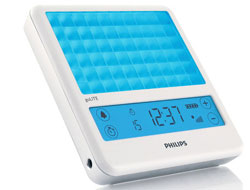The NY Times posted a fascinating article on LED lamps; that they can – and will – be used for more than illumination.
In the future, they could well be used to improve health, moods and food production by taking advantage of their ability to shift colors.
Besides being the most energy efficient lighting technology to date, LEDs can be programmed to create light in multiple colors that can make you feel more alert, calm or sleepy.
A company called Tabu, already makes a bulb that can be dimmed or programmed to change colors via your smartphone.
And Philips sells a range of "energy-enhancing" lights, such as goLITE BLU which counteracts the "winter blues" through a panel of blue LEDs. It also has a Wake-up Light.

"You have to start thinking of light as a drug," Terry McGowan, director of engineering for the American
Lighting Association, told the NY Times.
A good drug, not a bad drug. Any artist knows that color affects mood. The blue end of the spectrum stimulates photoreceptors in the eyes that help you stay alert by reducing melatonin production (which puts you to sleep). When the amount of blue is reduced, melatonin production rises and you feel more relaxed and sleepy.
This summer, Lighting Science says it will debut "Rhythm Downlight," which can adjust the amount of blue light using a smartphone app based on your sleep schedule.
While the light won’t visibly change in color or brightness, your circadian system will sense it, according to the company.
Lighting manufacturers are also targeting innovations for hospitals and greenhouses.
Philip’s experimental HealWell system can change colors based on time of day, encouraging patients to wake up or feel more relaxed and sleep more easily. One study found that cardiology patients slept longer and experienced less depression when the LED was used, says the NY Times.
They are a natural fit for greenhouses, where lighting is crucial for growing crops. With LEDs, that process can be fine-tuned by using specific hues of color.
"We find the optimal light recipe for the grower," Udo van Slooten, general manager for horticulture at Philips Lighting, told the NY Times.
Soon, LEDs will be outfitted with sensors. That would enable them to direct light based on how many people are in a room and their location, and the lighting intensity could be raised or lowered depending on the age of the people in the room (older people may not see as well, needing more intense light). Combined with facial recognition technology they could identify stressed medical patients and tone hues down to more calming values.
Read the full article:

So called “Smart Lighting” systems are more likely than not to use LED lighting technology. It will be interesting to see where this technology goes over the next few years, and how fast innovations find their way into the homes and businesses of everyday people.